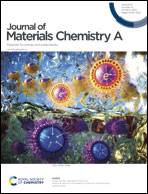The roles of nucleation and growth kinetics in determining Li metal morphology for Li metal batteries: columnar versus spherical growth†
Abstract
Li metal thin films have been considered one of the ideal anode materials for high energy density rechargeable batteries. Although recent efforts have shown promise in improving the electrochemical performance of Li metal, current Li metal technology still suffers from challenges derived from Li dendrite formation during cycling. This is due to the uncontrollable growth of Li metal during electroplating. Recently, columnar Li metal thin films have attracted much attention because of their unique morphology. However, the formation mechanism of columnar Li metal is not yet fully understood. Herein, the formation mechanism of columnar and spherical Li metal is demonstrated in terms of competition among the kinetics of heterogeneous Li nucleation on the substrate, Li growth, and homogeneous Li nucleation on Li metal, which is supported by the classical nucleation theory. Eventually, the thickness and diameter of columnar Li metal is precisely controlled by regulating the rates of the three reaction steps. The columnar Li metal electrodes also show improved electrochemical performance, such as stable capacity retention and high coulombic efficiency of Li|LiFePO4 full cells over 200 cycles, compared to conventional Li metal foil. These findings provide an opportunity to understand the principal factors in determining Li metal morphology during electroplating.



 Please wait while we load your content...
Please wait while we load your content...